Stars Park
Introduction
Text-to-speech Audio
Stars Park, also known as Compton Park, was home to the Negro League baseball team the St. Louis Stars from May 20, 1923 until 1931. Located between Compton, Laclede, and Market Streets, the park had a capacity of 16,000 and cost an estimated $27,000 to complete. The park's best-known feature was its left field advantage. At the time, a trolley barn stood north of Market Street about 250 feet from home plate. Any ball that hit the top of the barn was considered a home run, making Stars Park one of the best hitter parks in the National Negro League. When the St. Louis Stars disbanded during the 1931 season, the park was sold for $100,000 and turned into a playground. Today, the lot of the once great home run park is a Harris-Stowe State University baseball field.
Images
This historic marker is located at the site of the ballpark used by the St. Louis Stars and was placed by the Society of American Baseball Research.
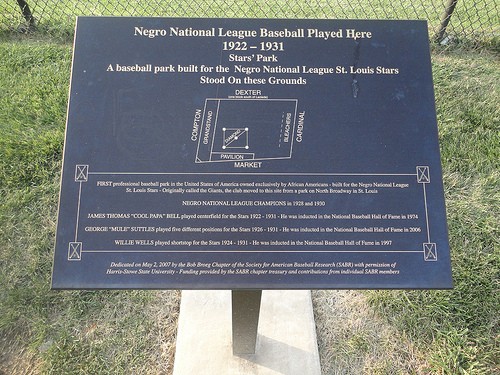
The 1928 World Champion St. Louis Stars- Image Courtesy of the Missouri History Museum
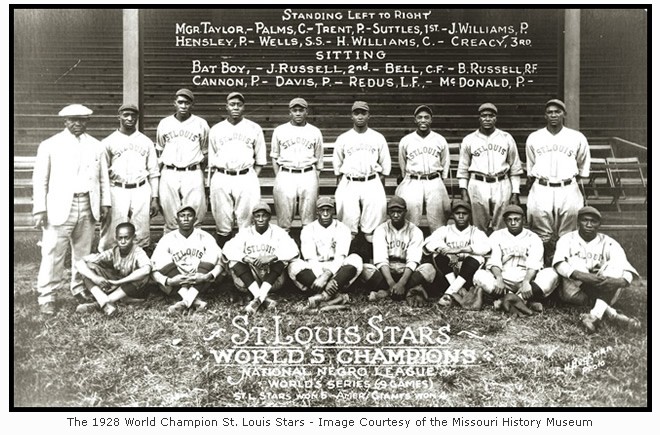
Cool Papa Bell
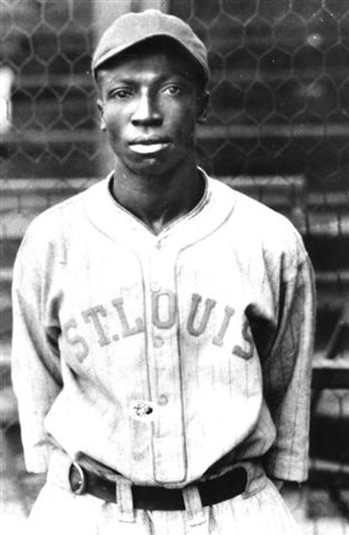
Willie Wells
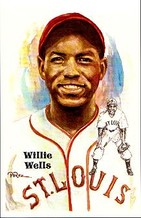
Mule Suttles
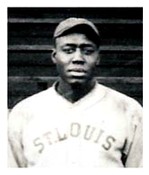
Backstory and Context
Text-to-speech Audio
The creation of the St. Louis Stars came out of the St. Louis Giants franchise organized by Charlie Mills in 1909.1 After Mills sold the franchise to Dick Kemp and Dr. Sam Sheppard in 1920, the name was changed to the St. Louis Stars.2 This renamed team needed a new home field to replace the Giants Park of previous seasons. The land for the new field was immediately purchased and construction began on Stars Park in 1922 making it one of the few ballparks built solely for a Negro League team.3 The Park was finished mid-season in 1922 and quickly became famous for its home run advantage.4
The St. Louis baseball franchise that led to the creation of the Stars has had many recreations since the 1920s; however, Stars Park was built for the original St. Louis Stars team of 1922 through 1931. According to The Biographical Encyclopedia of Negro Baseball Leagues, the Stars finished their first year at an even .500 for the season.5 The team experienced its only losing season in 1923.6 However, the Stars went on to win "three pennants in 1928, 1930, and 1931, winning playoffs the first two seasons against the Chicago American Giants and the Detroit Stars."7 Although the Stars had a rough start, the 1928 championship series gave the team the turn around it needed. The Stars "came from being down two games to none to win the series five games to four, with Willie Wells hitting six home runs in the last five series games played in St. Louis."8 This victory in part resulted from Stars Park's home run advantage. This hitter-friendly field turned a combined 32 runs and one home run in Chicago to 76 runs and 14 home runs in St. Louis. 9
The original St. Louis Stars had three players who were later inducted into the National Baseball Hall of Fame: Cool Papa Bell (1974), Willie Wells (1997), and Mule Suttles (2006).
James Thomas Bell, also known as Cool Papa Bell, was a center fielder for the Stars from 1922 until 1931.10 According to the Baseball Hall of Fame, "He was a member of three of the greatest Negro league teams in history, winning three championships each with the Stars, the Pittsburgh Crawfords, and the Homestead Grays."11 "Bell was a switch hitter and contact hitter, with great bat control, bunting ability, and speed."12
Willie James Wells primarily played shortstop for the Stars from 1924 until 1931.13 Wells established his baseball career in the United States, Canada, Cuba, and Mexico where he earned the nickname El Diablo.14 He was also selected to play in all-star games eight times and went on to mentor younger players including Jackie Robinson and Monte Irvin.15
Mule Suttles played first baseman for the Stars from 1926 until 1930, but he is most recognized for his time with the Newark Eagles.16 "The slugging first baseman and outfielder had a playing career that lasted the entire Golden Era of Negro leagues baseball, from 1921 to 1944."17
The St. Louis baseball franchise that led to the creation of the Stars has had many recreations since the 1920s; however, Stars Park was built for the original St. Louis Stars team of 1922 through 1931. According to The Biographical Encyclopedia of Negro Baseball Leagues, the Stars finished their first year at an even .500 for the season.5 The team experienced its only losing season in 1923.6 However, the Stars went on to win "three pennants in 1928, 1930, and 1931, winning playoffs the first two seasons against the Chicago American Giants and the Detroit Stars."7 Although the Stars had a rough start, the 1928 championship series gave the team the turn around it needed. The Stars "came from being down two games to none to win the series five games to four, with Willie Wells hitting six home runs in the last five series games played in St. Louis."8 This victory in part resulted from Stars Park's home run advantage. This hitter-friendly field turned a combined 32 runs and one home run in Chicago to 76 runs and 14 home runs in St. Louis. 9
The original St. Louis Stars had three players who were later inducted into the National Baseball Hall of Fame: Cool Papa Bell (1974), Willie Wells (1997), and Mule Suttles (2006).
James Thomas Bell, also known as Cool Papa Bell, was a center fielder for the Stars from 1922 until 1931.10 According to the Baseball Hall of Fame, "He was a member of three of the greatest Negro league teams in history, winning three championships each with the Stars, the Pittsburgh Crawfords, and the Homestead Grays."11 "Bell was a switch hitter and contact hitter, with great bat control, bunting ability, and speed."12
Willie James Wells primarily played shortstop for the Stars from 1924 until 1931.13 Wells established his baseball career in the United States, Canada, Cuba, and Mexico where he earned the nickname El Diablo.14 He was also selected to play in all-star games eight times and went on to mentor younger players including Jackie Robinson and Monte Irvin.15
Mule Suttles played first baseman for the Stars from 1926 until 1930, but he is most recognized for his time with the Newark Eagles.16 "The slugging first baseman and outfielder had a playing career that lasted the entire Golden Era of Negro leagues baseball, from 1921 to 1944."17
Sources
1- "St. Louis Stars." Negro Leagues Baseball Museum, n.d. Web. 30 Mar. 2015..
2- "St. Louis Stars." Negro Leagues Baseball Museum, n.d. Web. 30 Mar. 2015 .
3- Johnson, Kevin. "The History of a St. Louis Baseball Franchise: The Original St. Louis Stars." Seamheads.com. N.p., Dec. 2010. Web. 30 Mar. 2015. .
4- Johnson, Kevin. "The History of a St. Louis Baseball Franchise: The Original St. Louis Stars." Seamheads.com. N.p., Dec. 2010. Web. 30 Mar. 2015. .
5- "St. Louis Stars." Negro Leagues Baseball Museum, n.d. Web. 30 Mar. 2015 .
6- "St. Louis Stars." Negro Leagues Baseball Museum, n.d. Web. 30 Mar. 2015 .
7- "St. Louis Stars." Negro Leagues Baseball Museum, n.d. Web. 30 Mar. 2015 .
8- "St. Louis Stars." Negro Leagues Baseball Museum, n.d. Web. 30 Mar. 2015 .
9- "The 1928 Negro National League Championship: St. Louis Forgotten World Champions." Negro Leagues Baseball Museum, n.d. Web. 30 Mar. 2015 .
10- "Cool Papa Bell." Baseball Hall of Fame, n.d. Web. 30 Mar. 2015 .
11- "Cool Papa Bell." Baseball Hall of Fame, n.d. Web. 30 Mar. 2015 .
12- "Cool Papa Bell." Baseball Hall of Fame, n.d. Web. 30 Mar. 2015 .
13- "Willie Wells." Baseball Hall of Fame, n.d. Web. 30 Mar. 2015 .
14- "Willie Wells." Baseball Hall of Fame, n.d. Web. 30 Mar. 2015 .
15- "Willie Wells." Baseball Hall of Fame, n.d. Web. 30 Mar. 2015 .
16- "Mule Suttles." Baseball Hall of Fame, n.d. Web. 30 Mar. 2015 .
17- "Mule Suttles." Baseball Hall of Fame, n.d. Web. 30 Mar. 2015 .
